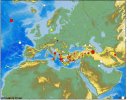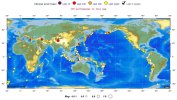Sea-floor sensors will investigate the geological unrest that shook the islands last year.
Richard Monastersky
20 July 2012
As tourists gambol around the Greek islands this summer, an international team of geoscientists is embarking on a research cruise to deploy instruments on the sea floor near one of the region's most famous holiday destinations, Santorini. The team hopes to keep tabs on a massive volcano there that showed signs of unrest last year.
“We want to see if there is any deformation of the sea floor, which may be related to possible [volcanic] inflation of the area,” says geologist Dimitris Sakellariou, from the Hellenic Centre for Marine Research (HCMR) in Anavyssos, near Athens, who is the cruise leader.
The Santorini caldera is a mostly submerged volcanic crater, with raised edges that form a picturesque arc of islands in the southern Aegean Sea. The arc is all that remains of an island, the centre of which collapsed during an eruption tens of thousands of years ago. In about 1650 bc, the volcano unleashed a series of massive eruptions that many blame for bringing down the Minoan civilization, which was centred on nearby Crete.
The largest submerged caldera in the world, Santorini last erupted in 1950 and had been relatively quiet until early 2011, when small earthquakes started to rattle the islands. The region remained fitful throughout 2011, and measurements using the Global Positioning System (GPS) revealed that the eastern and western edges of the caldera had spread apart by 14 centimetres between January 2011 and January this year1. Although the earthquake activity died down early in 2012, the sudden changes have left researchers unsure whether the volcano is resuming its slumber or preparing for a future blast.
Caldera cruise
The current research expedition will install instruments that could help to answer that question. It was a piece of fortuitous timing for Sakellariou and the cruise principal investigators, geologist Javier Escartin from the Earth Physics Institute in Paris (IPGP) and robotics engineer Pere Ridao of the University of Girona in Spain. Before the unrest at Santorini, they had already applied for European Commission funding through the EUROFLEETS programme to carry out a cruise there to test a new autonomous underwater vehicle and study hydrothermal venting from the caldera. After activity at the volcano picked up last year, IPGP and HCMR funded the installation of monitoring equipment on the sea floor.
During the two-week cruise this month, the researchers are installing a tiltmeter and two underwater pressure sensors to track the vertical movement of the sea floor. They are also fixing geodetic survey markers to the seabed so that future expeditions can monitor how it has deformed over time.
Another suite of instruments will analyze the temperature and chemistry of the hydrothermal fluids and gases seeping out of sea-floor vents. The team will leave some temperature sensors in place to monitor how the vent activity evolves.
Early measurements show that the temperature of fluids escaping at one site has risen by 1.5 ºC in the past couple of years, but Sakellariou stresses that the team needs to make many more measurements to determine whether the change is significant. In addition to using the autonomous vehicle to map the sea floor, the researchers are diving in the HCMR's Thetis submersible and using a remotely controlled vehicle to explore the submerged parts of the caldera, which reach a depth of 380 metres.
The data from the cruise and the deployed instruments could help to decipher what is happening deep within the volcano, says Andrew Newman, a geophysicist at the Georgia Institute of Technology in Atlanta, who is studying Santorini using GPS receivers at sites on land. The GPS measurements so far suggest that some material within the volcano — either magma or volatile gases — moved up to within 4 kilometres of the sea floor during 2011. If the material rises to within 2 kilometres, measurements from the submerged caldera will be crucial for tracking the movement inside the volcano, says Newman, who plans to return to Santorini this autumn for another GPS campaign.
The caldera monitoring team, meanwhile, is aiming to revisit the instruments next summer to see if the sea floor is deforming. Right now, things are quiet there, but Sakellariou says: “We must know what is going on, and we have to be ready to advise the government if some measures have to be taken in order to protect people’s lives.”






